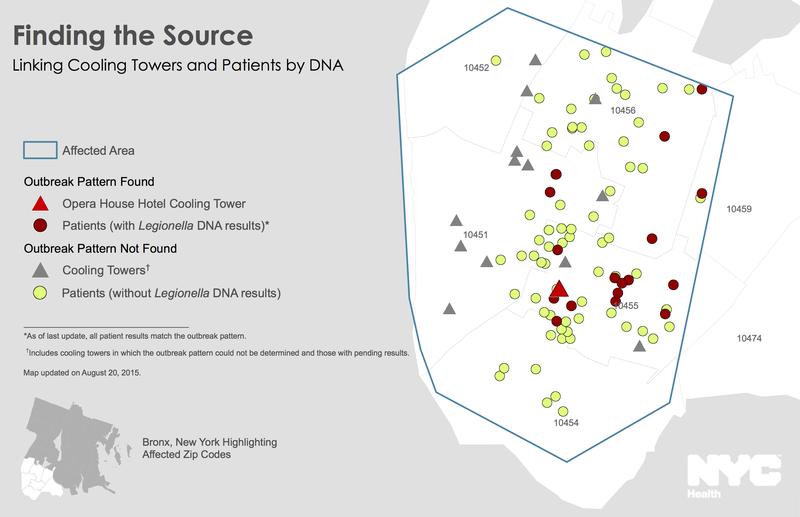How to Stop an Outbreak
How to Stop an Outbreak
An unwelcomed stranger snuck into the city last summer, and New Yorkers were panicking.
A sudden outbreak of Legionnaires’ disease, a type of pneumonia caused by waterborne bacteria, had landed in the city in July. In just over two weeks, there were already 81 cases and seven deaths — and the source of the deadly bacteria was a mystery.
When the New York City Health Department got the alert, they realized this wasn’t like any outbreaks of the disease they’d seen before.
“We’re incredibly nervous and worried. We don’t know how this started, we don’t know how it’s going to proceed, and we don’t know how it’s going to end,” said Dr. Jay Varma, Deputy Commissioner of Disease Control.
When mapping out the outbreak, however, his team noticed that the disease wasn’t just choosing victims at random. Most of the patients were from a cluster of neighborhoods in the South Bronx, an area historically marked by neglect and poverty. The city needed to track them down, and quickly.
 The area affected by Legionella bacteria.
(City of New York)
The area affected by Legionella bacteria.
(City of New York)
But getting that kind of information from severely ill people would not be easy. One of them, a 31-year-old taxi driver named Daniel Tejada, was heavily medicated and lying face down on a hospital bed with a 104-degree fever. It was challenging for Varma and his team to find out where exactly Tejada and the others had been exposed.
“They didn’t all go to the same hospital, they didn’t go to the same doctor, they didn’t swim in the same pool, or hang out at the same fountains,” he said.
The officials ruled out running water, which would have affected many more people at once. Instead they set their sights higher – on the roofs of large, commercial buildings where cooling towers are installed. The towers (which have nothing to do with drinking water) are meant to cool hot air within buildings, and emit mist. If the water in these systems are not properly treated, they can grow bacteria, including Legionella – which can cause a serious type of pneumonia when that mist is inhaled.
Over the next few days, “disease detectives” climbed up the buildings, testing water from the cooling towers and submitting their specimens to a lab in Albany. They narrowed down the search to five suspect water coolers in the South Bronx, and shared this information with the public.
 Noel Rivera, from Clarity Water Technologies, cleans up after helping drain and power-wash a cooling tower in Manhattan.
(Fred Mogul/WNYC)
Noel Rivera, from Clarity Water Technologies, cleans up after helping drain and power-wash a cooling tower in Manhattan.
(Fred Mogul/WNYC)
Varma and his team at the health department still didn’t have all the answers to appease an anxious public. Though they eventually tracked the source to one cooling tower, they couldn’t be sure. They still needed to grow more Legionella in the lab and match it to the bacteria in infected people to confirm that they had indeed cleaned the right unit, which would take weeks.
Annie Minguez, Daniel Tejada’s cousin, spoke at a town hall meeting to share her frustration.
“I cannot sleep at night knowing that possibly he could get this again,” she said. “That’s all I came here for.”
With a nervous city on his hands, Governor Andrew Cuomo got involved, and called in the Centers for Disease Control to start a “massive testing effort.” Hundreds of city workers and scientists were dispatched to find any overlooked cooling towers, and to sample them. New legislation was passed that required building owners in the entire city, not just the Bronx, to clean their cooling towers within two weeks.
In the public’s eyes, this mass effort was something close to heroic. The deaths stopped, new cases weren’t reported. The whole city seemed to be actively fighting this strange disease.
But it was the city health department, quietly waiting for the Legionella to grow in labs, that would truly put an end to the outbreak. Dr. Varma and his team were able to match the bacteria samples to one single water cooler tower on top of a hotel. A tower they had, luckily, cleaned weeks before.
“Every outbreak has something where you just get lucky,” he said. “You’re not just smart but something right happens at the right time.”